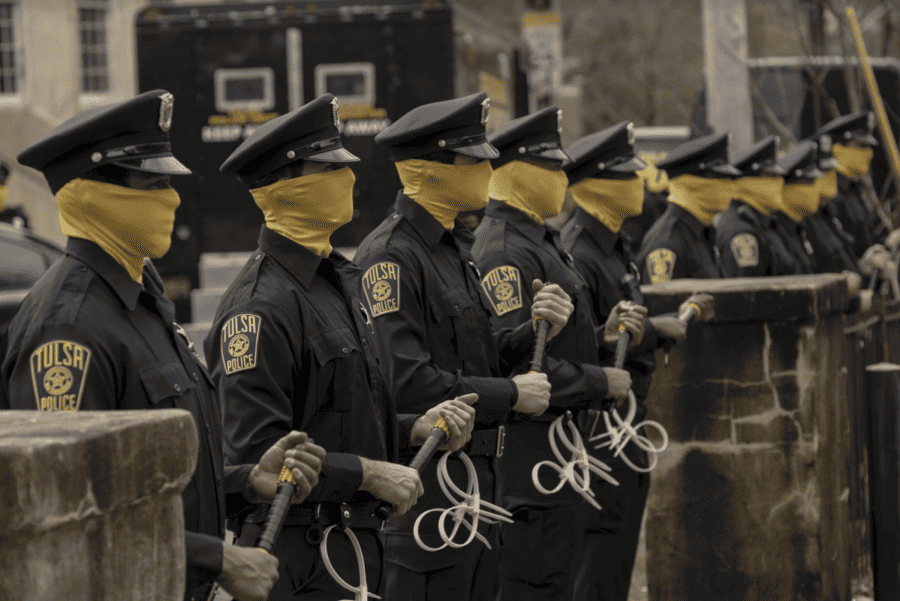The Splash Page: “Watchmen” is more than just a TV show
November 13, 2019
“Watchmen” starts with Superman. The new HBO series begins during the 1921 Tulsa race riot, a terrifying scene from America’s not-so-distant past. A young, black family sends their son rocketing out of the city in a wagon and into the cornfields of the heartland. He and another child are the only survivors. In this way, we are reminded immediately of Kal-El, sent from Krypton in its last moments, landing in the American heartland, surviving. This is a DC Comics adaptation, after all.
The classic Alan Moore and Dave Gibbons graphic novel establishes its starting point where all superhero stories start, with the publication of “Action Comics” #1 in 1938 and the first appearance of the Man of Steel. ”Watchmen” was published by DC Comics, after all. Heroes in the “Watchmen” world were inspired by comic books to become vigilantes in the “real” world, and in doing so, change the course of history forever. In “Watchmen,” superheroes are broken, outcasts who dress up in costumes because of deep psychological problems. They are far from being the good guys. It is a deconstruction of the superhero genre, a repudiation of the superhero’s prominence in comic books.
“Watchmen” is also a meta-narrative, something often lost in the discussion of the landmark graphic novel. The characters are thinly veiled versions of Steve Ditko’s (co-creator of Spider-Man) Action Heroes, originally published by Charlton Comics and later purchased by DC. The 9-panel grid, a revolutionary storytelling tool, is pulled from Ditko’s work. The famous Rorschach, recast in the new series as inspiration for a white supremacist organization, is deeply far-right, mirroring Ditko’s own objectivist views. He speaks like classic comedy comic book character Herbie Popnecker, an in-joke of an in-joke if there ever was one. “Watchmen,” as a meta-narrative, supposes a world where other genres prevailed in the medium of comic books. Superheroes and comic books are bad things, “Watchmen” says, all the while winking at them, playing with their ideas.
The best responses to “Watchmen” have been, themselves, meta-narratives. In recent years, the original graphic novel has gone through something of a critical re-imagining, and superhero comics have been part of that. Grant Morrison and Frank Quitely’s “Multiversity: Pax Americana #1” re-casts the Watchmen crew as the original Charlton Characters and makes an entire issue into a sort of 9-panel grid. Kieron Gillion and Caspar Wungaard’s “Peter Cannon: Thunderbolt” weaves a “Watchmen” response via Peter Cannon, the original version of Ozymandias (portrayed in the new series by Jeremey Irons). DC’s “Justice League: The New Frontier,” and other stories, justify the disappearance of DC’s World War II heroes as enforced by HUAC and the Red Scare. Even Disney-Pixar’s “The Incredibles” is heavily inspired by “Watchmen,” in many ways recalling and doubling-down on Ditko and Rorschach’s right-wing McCarthy-era messages.
This new “Watchmen” is more than an adaptation of the original graphic novel. In fact, it isn’t an adaptation at all. HBO calls it a “remix,” and it serves as a semi-sequel to the events of the original text. It is set not in 1986 but 2019, not in New York but in Tusla, Oklahoma, and it returns to the classic “Watchmen” image of superheroes-as-authority by introducing us to a world where police wear masks and go by code names in order to protect their identities. White supremacists, inspired by the Rorscach, hunt police officers and threaten to turn Tulsa into a war zone.
Race is the centerpiece of the story; this is a part of America the original “Watchmen” never came close to touching. This series is not content to return just to the 1980s questions of safety, freedom and fascism of the original story. This is a story about America, something superhero comic books often are. This is a story about this moment, just as “Watchmen” was a story about rising crime and new threats of annihilation in nuclear war.
The original “Watchmen” came the same year as DC Comics published “Crisis on Infinite Earths” and the “realistic” world of the former heavily influenced the post-“Crisis” reboot of the DC Universe after the latter. It says something that the bevy of DC Comics television series on The CW are adapting “Crisis” this year, just as the new “Watchmen” is coming to HBO. As in 1985, we are fascinated by stories about comic books, this time told in comics and on our screens. We are fascinated to learn why we are so fascinated by superheroes, all over again.
“Supergirl,” on The CW, is adapting the recently completed “Leviathan” story arc from the Superman family of comics, a story tied up in the ramifications of DC’s comic-book sequel/crossover with “Watchmen,” “Doomsday Clock.” Characters first introduced in “Doomsday Clock” have been cast for the HBO series. The series, across networks and mediums, across authors and time and production schedules, are in dialogue with each other.
This new “Watchmen” presents itself, at first, as a prestige series. There are takes, justifiably, in publications like Slate, and if the typical HBO audience member has read any comic book, it is “Watchmen.” And yet, it begins not with Ozymandias’ attack on New York, not with the end of the graphic novel, but with a re-telling of the origin of Superman, a re-telling set not in outer space but in Tulsa, not with an immigrant but with a young black boy, not with an exploding planet but with a terrible and violent strand of hatred that still has power in America today.
When I first heard about this adaptation, I groaned. I have never enjoyed revisiting “Watchmen,” have never enjoyed the message inherent in the original that the things I like are trashy, lowbrow, not worth reading about. And yet, this new series takes all that prestige and returns, quickly, to the lowbrow, to the superheroic. It is in dialogue with the DC Universe, with comic books and – let’s face it – the lowbrow entertainment of The CW.
This new “Watchmen” knows, at least, that it is taking on those textual problems of the original: freedom, security, American culture and politics and the nature of humanity. It is a story about what America really is, who our heroes really are. It is a story about real problems, real hatred and violence that our nation must face every day. But it also knows that it is a meta-textual story, that it has chosen television adaptation as it’s form. That in itself is a comment on the movement of the superhero from children’s junk to elite entertainment.
It is a story, we are told from the beginning, about race and violence and heroes. I am intrigued by this new “Watchmen.” I do not yet know what it will end up saying about superheroes, about comic books and adaptations. There are still many episodes left in the season. But, when it is all over, there will be something interesting there at least. It will tell us something, I am sure, about who we are, and why we watch and read and think about the things we do.











